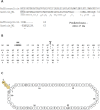Raffinocyclicin is a novel plasmid-encoded circular bacteriocin produced by Lactococcus raffinolactis with broad-spectrum activity against many gram-positive food pathogens
- PMID: 39189737
- PMCID: PMC11409674
- DOI: 10.1128/aem.00809-24
Raffinocyclicin is a novel plasmid-encoded circular bacteriocin produced by Lactococcus raffinolactis with broad-spectrum activity against many gram-positive food pathogens
Abstract
This study describes the discovery and characterization of raffinocyclicin, a novel plasmid-encoded circular bacteriocin, produced by the raw milk isolate Lactococcus raffinolactis APC 3967. This bacteriocin has a molecular mass of 6,092 Da and contains 61 amino acids with a three-amino acid leader peptide. It shows the highest identity to the circular bacteriocins bacicyclicin XIN-1 (42.62%), aureocyclicin 4185 (42.62%), and garvicin ML (41.53%). A broad inhibitory spectrum includes strains from Staphylococcus, Enterococcus, Streptococcus, Micrococcus, Lactobacillus, Leuconostoc, and Listeria, in addition to a pronounced inhibitory effect against Lactococcus and Clostridium. It displays low sensitivity to trypsin, most likely as a result of its circular nature. The raffinocyclicin gene cluster is composed of 10 genes: 6 core genes, genes encoding an accessory three-component ABC transporter (rafCDE), and a putative transcriptional regulator related to the MutR family. A lack of inhibitory activity in the cell-free supernatant combined with the pronounced activity of cell extracts suggests that the majority of raffinocyclicin is associated with the cell rather than being released to the extracellular environment. This is the first report of a bacteriocin produced by the L. raffinolactis species.IMPORTANCEThe present study aimed to characterize raffinocyclicin, a novel circular bacteriocin produced by the lactic acid bacteria Lactococcus raffinolactis APC 3967. Bacteriocins are generally cationic and hydrophobic peptides with antimicrobial activity, which present diverse biotechnological properties of interest for the food industry. Raffinocyclicin inhibits a wide range of bacteria, including foodborne pathogens, and is stable against different treatments which suggest its potential as a natural biopreservative. Whole-genome sequencing and the genetic analysis of the raffinocyclicin gene cluster showed that it is encoded by plasmid that could be used in the future to transfer the ability to produce the bacteriocin to other lactic acid bacteria for industrial applications. These results together highlight the potential of this novel antimicrobial as a biopreservative to be used by the food industry.
Keywords: Lactococcus raffinolactis; antimicrobial activity; antimicrobial peptide; circular bacteriocin; raffinocyclicin.
Conflict of interest statement
The authors declare no conflict of interest.
Figures








References
Publication types
MeSH terms
Substances
Grants and funding
LinkOut - more resources
Full Text Sources
Medical
Molecular Biology Databases

